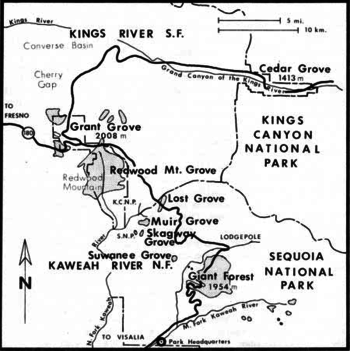Redwood Mountain Grove

Redwood Mountain Grove is the largest grove of giant sequoia (Sequoiadendron giganteum) trees on earth.[1] It is located in Kings Canyon National Park and Giant Sequoia National Monument on the western slope of California's Sierra Nevada. The grove contains the world's tallest giant sequoia (95 metres (312 ft)).[2] The Hart Tree and Roosevelt Tree grow in the grove and are two of the 25 largest trees by volume in the world. The largest tree is the General Sherman Tree in the Giant Forest grove to the southeast.
The Grove
The Redwood Mountain Grove contains the most giant sequoia trees within its area.[3] The area has old-growth giant sequoia groves and other distinctive natural features of the forest for visitors to view and experience. The Redwood Mountain Grove is protected primarily within Kings Canyon National Park, and in Giant Sequoia National Monument.
Trails
The grove's 3 hiking trails are: the Redwood Canyon Trail (central grove); Sugar Bowl Trail (southwest); and the Hart Tree Trail (northwest). Their total 10 miles (16 km) length connect for 3 loop route options.[4][5] They all begin at the Redwood Canyon Trailhead, via the dirt Forest Service Route 14S75 off the Generals Highway.[6] They give visitors walking/hiking access to see giant sequoia trees within 'wilderness' natural habitats and views of the surrounding canyons and mountains. In Redwood Canyon along Redwood Creek, the grove's understory is dense with other native plant species. The Sugar Bowl is an unusual pure giant sequoia grove on top of Redwood Mountain.[7][8]
Plant Life and Fire Studies
The grove contains many types of plant life, with the most significant being the tall giant sequoias. It also includes many types of trees within the area, and the trees that are most prominent in the grove include species such as the white fir, sugar pine, incense cedar, ponderosa pine, red fir, and Jeffrey pine. Each type of tree is most numerous different sections of the grove. The trees have a significant importance to the grove, and natural disasters such as fires have many effects on it. In 1969, parts of the grove were burned to prevent the possibility of other fires from happening, and they aided in restoring the ecosystem and natural life in the area. Fires such as these were also used for scientific research. The fires can have major effects on forests and other wilderness areas. The fires can act as part of the natural cycle for restoring natural life in the environment and ecosystems in the grove and other parks.[9] The Redwood Mountain Grove was involved in several studies that looked at different species of trees present in the grove and the environment surrounding the area. Some of these studies included the investigation of how fires affected the trees and environment in the grove.[10]
The Redwood Mountain Grove was used for the study and analysis of several fire burnings. The burnings of small areas in the grove occurred to observe and understand the effects of different fires on the environment and dangerous products eliminated. It also presented the benefits to the grove through the examination of the results of the areas burned. They highlighted the effects fires have on the many trees, other natural life, and wilderness of the Redwood Mountain Grove and its surroundings.[11]
Noteworthy trees
Some of the significant trees found in the grove include:
- Roosevelt Tree — the largest tree in the grove with a volume of over 1,000 cubic metres (35,000 cu ft).
- Hart Tree — a very tall tree with a volume of around 980 cubic metres (35,000 cu ft), and a huge basal burn. Located near the Roosevelt Tree.
- Unnamed tree — the tallest known giant sequoia tree, at 311 feet (95 m) in height.
See also
References
- ↑ Mike White (2004). Kings Canyon National Park: A Complete Hiker's Guide. Wilderness Press. p. 51.
- ↑ "Gymnosperm Database: Sequoiadendron giganteum". Retrieved 2007-06-10.
The tallest known giant sequoia is a specimen 94.9 m tall, first measured August 1998 in the Redwood Mountain Grove, California
- ↑ "King's Canyon National Park". National Parks Conservation Association. Retrieved 7 December 2014.
- ↑ Google Books: Kings Canyon National Park; by Mike White; Trip 3 - Redwood Mountain Grove, Hart Loop Trail, pg. 48-50.
- ↑ Google Books: Kings Canyon National Park; by Mike White; Trip 4 - Redwood Mountain Grove, Sugar Grove Loop Trail, pg. 51-53.
- ↑ Google Maps: Redwood Canyon Trailhead area
- ↑ "Redwood Mountain Grove". Redwood Hikes.com. Retrieved 17 August 2015.
- ↑ Google Books: Sequoia and Kings Canyon National Park: Must-Do Hikes for Everyone; by Mike White; Trail 16 (chapter) - Redwood Mountain Grove.
- ↑ Kilgore, Bruce M.; Taylor, Dan (February 1979). "Fire History of a Sequoia-Mixed Conifer Forest". Ecology. Ecological Society of America. 60 (1): 129–142. doi:10.2307/1936475. JSTOR 1936475.
- ↑ Rundel, Philip W. (January 1973). "The Relationship Between Basal Fire Scars and Crown Damage in Giant Sequoias". Ecology. Ecological Society of America. 54 (1): 210–213. doi:10.2307/1934393. JSTOR 1934393.
- ↑ St. John, Theodore V.; Rundel, Philip W. (1976). "The Role of Fire as a Mineralizing Agent in a Sierran Coniferous Forest". Oecologia. Springer in cooperation with International Association for Ecology. 25 (1): 35–45. doi:10.1007/bf00345032. JSTOR 4215301.
External links
| Wikimedia Commons has media related to Redwood Mountain Grove. |
Coordinates: 36°41′38″N 118°55′08″W / 36.6938351°N 118.9189942°W